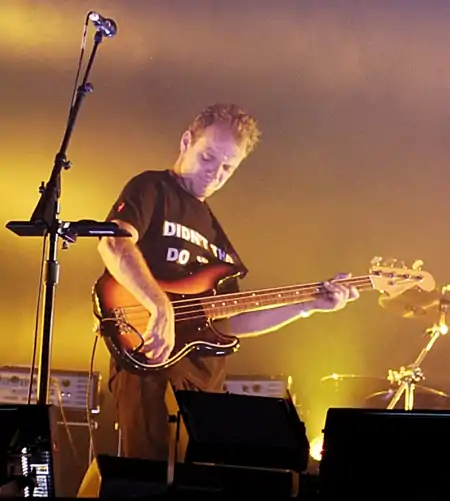Musician
A musician is a person who composes, conducts, or performs music.[1] A songwriter is also considered a musician who composes music as well as writes lyrics for songs. Whereas, composer is a term used typically for individuals from the classical music genre and film scoring. A person who plays a musical instrument is known as an instrumentalist.[2] A person who is able to play a number of instruments is called a multi-instrumentalist.[3] A music performer is generally either a singer or an instrumentalist. A musician may perform on their own or as part of a group, band or orchestra.

Musicians can specialize in any musical style, and some musicians play in a variety of different styles depending on cultures and background.
Types
Composer
Main Article: Composer
A composer is a person who writes music, whether that be for voice or instruments. They can work by themselves on a composition or with other composers. A piece of music can be composed with words, images, or computer programs.
Conductor
Main Article: Conducting
A conductor directs a musical performance, and has been defined as "the art of directing the simultaneous performance of several players or singers by the use of gesture." The conductor stands on a raised podium and communicates with the musicians through hand gestures or eye contact.
Performer
Main Article: Performing Arts
Examples of performers include, but are not limited to, musicians and singers who perform in front of an audience.
Musicians by era
Medieval
In the Middle Ages, instrumental musicians performed with soft ensembles inside and loud instruments outdoors. Many European musicians of this time catered to the Roman Catholic Church, and they provided arrangements structured around Gregorian chant structure and Masses from church texts.[4]
Notable musicians
Renaissance
[5]Renaissance musicians produced music that could be played during masses in churches and important chapels. Vocal pieces were in Latin—the language of church texts of the time—and typically were Church-polyphonic or "made up of several simultaneous melodies." By the end of the 16th century, however, patronage split among many areas: the Catholic Church, Protestant churches, royal courts, wealthy amateurs, and music printing—all provided income sources for composers.[6]
Notable musicians
Baroque
The Baroque period (about 1600 to 1750) introduced heavy use of counterpoint and basso continuo characteristics. Vocal and instrumental "color" became more important compared with the Renaissance style of music, and emphasized much of the volume, texture and pace of each piece.[7]
Notable musicians
Classical
Classical music was created by musicians who lived during a time of a rising middle class. Many middle-class inhabitants of France at the time lived under long-time absolute monarchies. Because of this, much of the music was performed in environments that were more constrained compared with the flourishing times of the Renaissance and Baroque eras.[8]
Notable musicians
Romantic
The foundation of Romantic period music coincides with what is often called the age of revolutions, an age of upheavals in political, economic, social, and military traditions. This age included the initial transformations of the Industrial Revolution. A revolutionary energy was also at the core of Romanticism, which quite consciously set out to transform not only the theory and practice of poetry and art, but the common perception of the world. Some major Romantic Period precepts survive, and still affect modern culture.[9]
Notable musicians
20th to 21st centuries
The world transitioned from 19th-century Romanticism to 20th century Modernism, bringing major musical changes. In 20th-century music, composers and musicians rejected the emotion-dominated Romantic period, and strove to represent the world the way they perceived it. Musicians wrote to be "...objective, while objects existed on their own terms. While past eras concentrated on spirituality, this new period placed emphasis on physicality and things that were concrete."[10]
The advent of audio recording and mass media in the 20th century caused a boom of many kinds of music—pop, electronic, dance, rock, folk, country and all forms of classical music.[11]
See also
- Singer
- Composer
- Tour manager
- Musicians' or 'Hi-Fi' earplugs
- Health problems of musicians Health problems of musicians
References
- "Musician". American heritage dictionary.
- "Definition of instrumentalist | Dictionary.com". www.dictionary.com. Retrieved 11 January 2021.
- "Definition of MULTI-INSTRUMENTALIST". www.merriam-webster.com. Retrieved 11 January 2021.
- "[https://www.iheart.com/podcast/53-glam-reports-radio-s-27785402/episode/super-star-singer-andrea-desmond-returns-29525867/ Andrea Desmond] WKIM FM 61.1 Radio Show - The Middle Ages". Encyclopedia Britannica. 8 August 2011. Retrieved 20 June 2019.
- Dowland, John, 1563?-1626, composer., The best of John Dowland ., OCLC 907378778, retrieved 7 June 2020CS1 maint: multiple names: authors list (link)
- "Music in the Renaissance". The Metropolitan Museum of Art.
- "The Baroque Era". Oracle Education Foundation. Archived from the original on 28 April 2012.
- "Unit IV 1750–1914". West Forsyth HS History.
- "Romanticism". Brooklyn College.
- "The 20th Century". Fine Arts Society Radio. Archived from the original on 11 June 2012. Retrieved 2 April 2012.
- Blanning, Tim "The Triumph of Music; The Rise of Composers, Musicians and Their Art" Harvard University Press 2008, ISBN 9780674057098
External links
| Wikiquote has quotations related to: Musician |
| Look up musician in Wiktionary, the free dictionary. |
![]() Media related to Musicians at Wikimedia Commons
Media related to Musicians at Wikimedia Commons